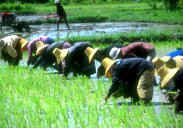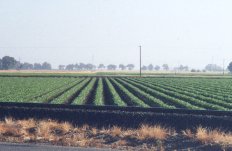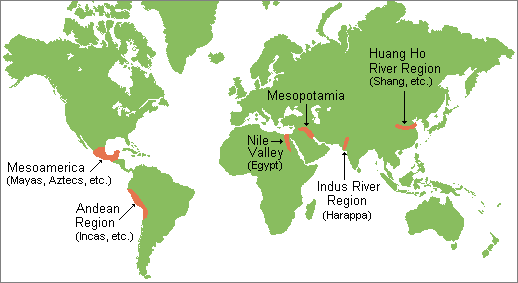Intensive
agriculture is the primary subsistence pattern of large-scale, populous
societies. It results in much more food being produced per acre compared
to other subsistence patterns. Beginning about 5,000 years ago, the
development of intensive farming methods became necessary as the human
population grew in some major river valleys to levels beyond the carrying capacity of the
environment using horticulture and pastoralism. The
transition to intensive agriculture was originally made possible by water
management systems and the
domestication of large animals for pulling plows. This allowed farmers
to get below the top soil to bring buried nutrients up to the surface.
It also allowed farmers to maintain much larger fields of crops.
 |
 |
|
|
Heavily fertilized and
irrigated |
Rice production in China
using |
The first intensive agricultural societies were the ancient civilizations in Egypt, Mesopotamia (now Iraq and eastern Syria), India and Pakistan, North China, Mesoamerica, and Western South America. Today, intensive agriculture is the primary food production pattern in all developed nations except those that are too arid or too cold for any form of farming outside of greenhouses. Over the last century, large-scale agricultural techniques spread rapidly throughout the world with the introduction of farm machines driven by internal combustion engines and the availability of commercially produced fertilizers, pesticides, and herbicides. This essentially resulted in the industrialization of farming in the richer nations.
|
|
|
Centers of ancient intensive agriculture based civilizations |
The transition to intensive agriculture brought with it a number of inevitable major social changes. Permanent year round settlements became necessary because the food source was immobile. As a consequence, more time and effort were expended in building houses that would last for generations. Surplus crops produced by farmers were sold in village markets. Some of these market centers increased in population over time and became towns and eventually cities. There was an evolution of a complex division of labor. Many new kinds of jobs appeared, including merchants, craftsmen, professional soldiers, priests, rulers, and bureaucrats. The emerging urban centers were occupied mainly by these non-food-producing specialists and their families.
|
|
|
|
Traditional West African |
|
The ancient civilizations became rigidly divided into social classes. The economic and political power of farmers was dramatically decreased as elite groups headed by kings increasingly monopolized power. The ruling class ended up controlling the sources of wealth--i.e, land, water, manufacturing, and trade. This required a radical change in the concept of ownership. In most small-scale societies with less intensive subsistence patterns, economically important properties, such as land and water wells, usually are not owned in the sense that we think of ownership today. Rather, this property is kept in stewardship for the society as a whole. An individual keeps the property only so long as it is being used. Strong pressures of reciprocity within the community require that property be shared or given away rather than hoarded if it is not being used. In order for a wealthy ruling class to emerge, this concept of ownership had to be replaced over time by one in which absolute personal property rights are paramount. This transition allowed for wealth to be accumulated by individuals and passed on to their descendants rather than returned to the society for redistribution. As a result, economic disparities developed between families over time. These disparities gave rise to economic class distinctions and non-egalitarian societies. As these major social changes were occurring, the status and power of women generally declined as well.
Modern
Large-Scale Societies
In large-scale societies today, agriculture has become highly efficient, requiring much fewer people to produce the food for everyone else. This is particularly true of mechanized grain farming and ranching. Technological advances in farm production now occur frequently and are spread world wide within a few years. Our new sources and uses of energy often require international trade on a global scale to acquire them. This is particularly true of petroleum products.
 |
 |
|
|
A large corporate farm in
North America |
Automatic seedling
planting system used |
 |
|
|
21st century
dense urban |
|
 |
|
|
Confident
woman military pilot |
In many of the poor developing nations in the tropical regions of the world, plantation agriculture has increasingly replaced subsistence horticulture. Plantations are large, labor-intensive farms that mostly produce fruit, sugar, fiber, or vegetable oil products for the international market. The laborers usually work for very low wages that keep them in poverty. Many of the plantations of Indonesia, Philippines, Central America, the Caribbean, and West Africa are owned by multinational corporations such as Dole and the National Fruit Company. The net effect of this form of agriculture generally has been the flow of wealth from poor nations in the southern hemisphere to rich ones in the northern hemisphere.
A
century ago, the typical North American family lived on a farm in a
multi-generational household. Today the common pattern is a nuclear
family
![]() household in an urban or suburban environment. The form of the
contemporary North American family is largely a result of the demands of the
work place. Corporations, governments, and other major employers are
often nationwide and even international in their operations. Many
commonly require their employees to move from
city to city and even country to country every few years. As a result,
it is extremely difficult for extended families to remain together in the same
community once the children grow up. We have become a people with few
long term community roots. It is not surprising that 3/4 of the people
living in California today were not born there. This pattern of frequent
job related migrations is now occurring across the globe.
household in an urban or suburban environment. The form of the
contemporary North American family is largely a result of the demands of the
work place. Corporations, governments, and other major employers are
often nationwide and even international in their operations. Many
commonly require their employees to move from
city to city and even country to country every few years. As a result,
it is extremely difficult for extended families to remain together in the same
community once the children grow up. We have become a people with few
long term community roots. It is not surprising that 3/4 of the people
living in California today were not born there. This pattern of frequent
job related migrations is now occurring across the globe.
We are moving into a post-industrial information-based economy in the U.S. and other economically dominant nations. There is an increasing emphasis on mental rather than hard physical labor. The economic and political power of women has risen significantly in part as a result of this change.

